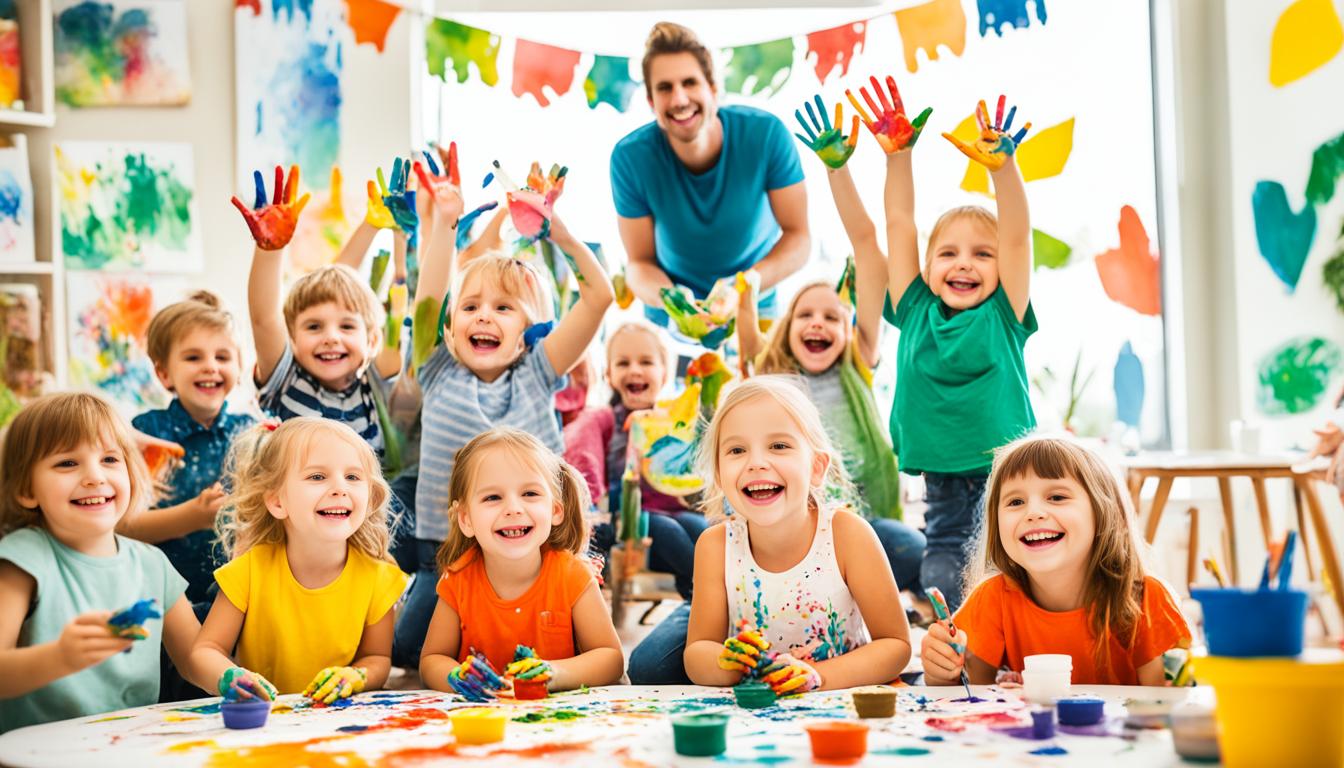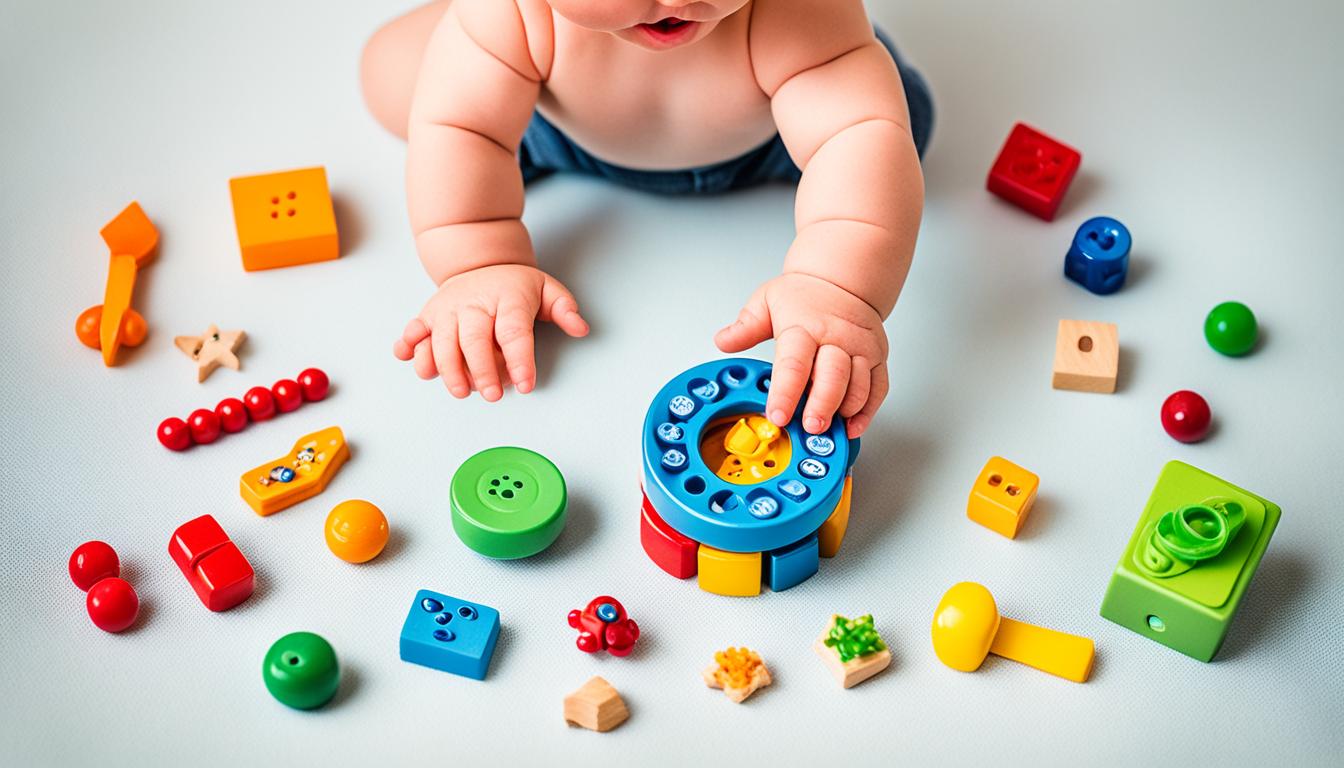Every child comes into the world with the amazing ability to be creative. This spark fuels their imagination, keeps their curiosity alive, and helps shape their distinct viewpoints. Cultivating this creativity is crucial for their growth and sets them up for a future full of innovation and achievement.
Imagine a young girl named Emily, who loved spending time in her backyard. Surrounded by nature’s wonders, she would transform fallen leaves into magical creatures, build castles out of twigs, and create imaginary worlds where anything was possible. In these moments, Emily’s creativity blossomed, and she embraced the joy of exploration and self-expression. Little did she know that through her imaginative play, she was developing essential cognitive and social skills that would shape her future.
According to Susan Engel, Ph.D., author of “Real Kids: Creating Meaning in Everyday Lives,” children as young as two and a half years old understand the distinction between real and pretend1. This early understanding lays the foundation for fostering creativity in children, as they navigate between the imaginary worlds they create and the real world they inhabit.
Creativity plays a pivotal role in early childhood education, fostering critical thinking skills and creative problem-solving abilities1. Through imaginative play, storytelling, and expressive art activities, children are encouraged to think outside the box, explore different perspectives, and make connections between seemingly unrelated concepts2. These experiences enhance their cognitive development, spatial awareness, and ability to approach problems with an open mind2.
Outdoor activities provide a fertile ground for nurturing creativity in children. In the natural environment, they have the opportunity to discover, create, and solve problems through hands-on exploration1. Whether building a fort with tree branches, observing insects, or simply playing in the mud, children engage in imaginative play that nurtures their creative thinking and problem-solving skills2.
Verbal activities, such as rhymes, riddles, and word games, can inspire and nurture creative minds while enhancing vocabulary and phonics skills1. Exploring the rhythm of language and the power of words allows children to express themselves, expand their communication skills, and refine their ability to convey ideas coherently2.
Art activities are another powerful tool for fostering creativity in children. Through painting, drawing, sculpting, and other forms of artistic expression, children can explore their emotions, make decisions, develop ideas, and enhance their fine motor skills and hand-eye coordination1. As they proudly showcase their creations, they also build confidence in their abilities and gain a sense of accomplishment2.
Reading activities that involve discussing scenarios or developing alternate story endings stimulate imagination and creativity in children1. When little Tim reads a book about a lost treasure, he may imagine himself as the fearless hero, embarking on a daring adventure to uncover the hidden riches. Through this imaginative exercise, Tim’s creativity flourishes, and he begins to form his unique perspective on the story2.
Limiting screen time is recommended to encourage active learning and creativity through kinesthetic engagement and sensory exploration1. By reducing the time spent on passive consumption, children are encouraged to actively engage with the world around them, exploring, creating, and bringing their imaginative ideas to life2.
Unstructured downtime is also crucial for nurturing creativity in children. When they have the opportunity to be bored or have free time, their imagination is sparked, and they can imagine and create freely1. In this relaxed setting, where there are no rules or expectations, the true essence of creativity unfolds, allowing children to develop their unique ideas and perspectives2.
Early childhood is a critical period for nurturing children’s imagination and creativity1. During these formative years, it’s vital to emphasize the importance of encouraging imaginative expressions, creative thinking, and providing a supportive environment where children can freely explore and express themselves1.
Key Takeaways:
- Imagination fosters cognitive and social development, building critical thinking and problem-solving skills12.
- Outdoor activities, verbal activities, art activities, and reading activities all play a crucial role in nurturing a child’s creativity12.
- Limiting screen time and allowing unstructured downtime are essential for encouraging active learning and free creative expression12.
- Early childhood is a critical period for nurturing imagination and creativity, emphasizing the importance of encouraging imaginative expressions and creative thinking1.
The Importance of Imagination in Child Development
Imagination plays a vital role in the development of children, providing them with a plethora of benefits that contribute to their cognitive, emotional, and social growth. Engaging in pretend play allows children to express themselves, think creatively, and distinguish between reality and make-believe scenarios. By incorporating imaginative play into their daily lives, children can foster their cognitive development and enhance critical thinking skills, preparing them for the complex problem-solving tasks they will encounter in the future workforce3.
One of the key advantages of imaginative play is its impact on social-emotional development. Through role-playing and creative problem-solving, children learn to navigate social interactions, mirror social norms, and develop empathy for others4. By taking on different roles and exploring various scenarios, children broaden their understanding of different perspectives, fostering a sense of compassion and empathy. This aspect of imaginative play is crucial for nurturing the social skills that are essential for forming meaningful relationships later in life.
Moreover, engagement in imaginative play promotes self-confidence and self-esteem in children. Choosing their own characters and identities to portray allows them to explore their own capabilities and build confidence in their abilities4. By immersing themselves in imaginary worlds, children feel empowered to imagine and create, which instills a sense of self-efficacy that can positively influence their self-image and overall well-being. The freedom to experiment with different communicational styles during imaginative play also contributes to improved language development4.
Imagination further facilitates physical development as children engage in various activities that promote active play. Whether they’re pretending to be soaring through the skies as an astronaut or crawling through a magical forest as an adventurer, children participate in physical movements that enhance their gross and fine motor skills4. This aspect of imaginative play supports their overall physical development, allowing them to build strength, coordination, and spatial awareness.
In addition to its individual benefits, imaginative play also promotes social development and cultivates skills that are essential for the future workforce. Many forms of imaginative play involve collaboration and sharing with others, leading to the development of crucial social skills and the formation of friendships4. These interpersonal interactions lay the foundation for effective teamwork, communication, and cooperation, which are all highly valued skills in the professional world.
Imagination is not only a source of joy and entertainment for children but also a fundamental aspect of their cognitive, emotional, and social development. Encouraging imaginative play in children not only fosters creativity but also equips them with the skills necessary to navigate their future endeavors34.
It is crucial for caregivers and educators to recognize the immense value of imaginative play and actively facilitate its incorporation into children’s lives. By providing resources, support, and engaging in alternative Halloween-themed activities during special occasions like Halloween, caregivers can further encourage imaginative play and reinforce safety regulations3. By nurturing and embracing children’s imagination, we can cultivate a generation of creative problem solvers, imaginative thinkers, and resilient individuals ready to contribute to the workforce of the future.
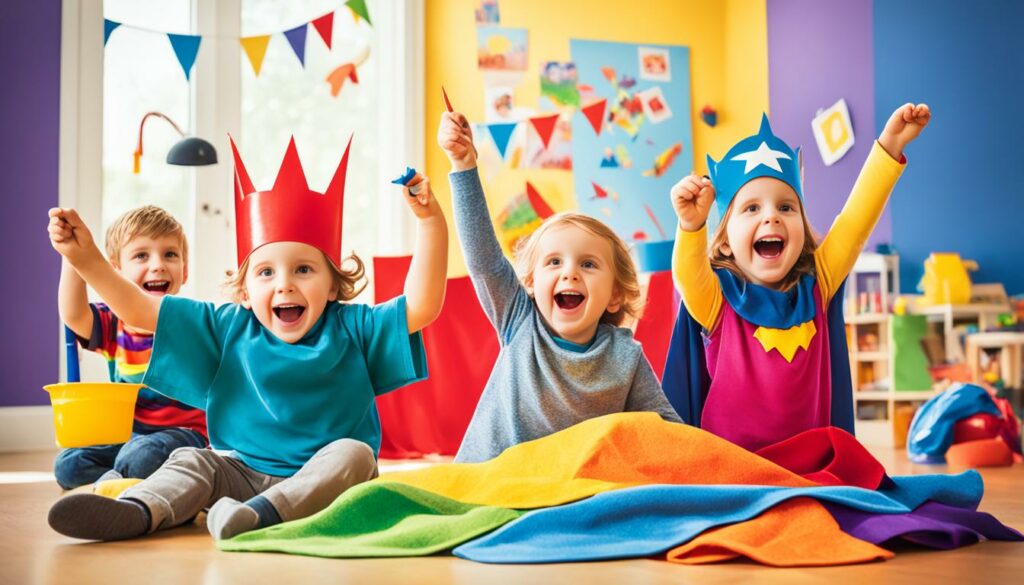
Benefits of Imagination in Child Development
| Benefits | Statistical Data Reference |
|---|---|
| Builds critical thinking skills | 3 |
| Increases social skills | 3 |
| Develops emotional management | 3 |
| Promotes self-confidence | 4 |
| Enhances language development | 4 |
| Fosters physical development | 4 |
| Encourages social interaction | 4 |
Tips for Nurturing Creativity in Children
When it comes to fostering creativity in children, there are various strategies and activities that can help unlock their imaginative potential. By incorporating these tips into their daily lives, parents and caregivers can inspire children to explore their creative abilities and develop critical thinking skills.
1. Spending Time Outdoors
One effective way to nurture creativity in children is by encouraging them to spend time outdoors. Outdoor environments provide endless opportunities for discovery, problem-solving, and imaginative play. Whether it’s exploring nature, building forts, or inventing new games, the outdoors stimulates a child’s curiosity and allows their creativity to flourish. Studies have shown that children who spend time outdoors have improved attention spans and lower stress levels compared to those who spend more time indoors5.
2. Inventing Scenarios
Encouraging children to invent scenarios and take on different roles can greatly stimulate their creative thinking. By engaging in pretend play, children can explore their imagination, problem-solve, and develop social skills. Pretend play allows children to step into different worlds, create their own narratives, and express themselves in unique ways. This form of play nurtures creativity by giving children the freedom to explore and experiment with their ideas.
3. Engaging in Verbal Activities
Verbal activities such as rhymes, riddles, and making up lyrics are excellent ways to promote imagination and creative thinking. These activities encourage children to think outside the box, come up with unique ideas, and express themselves verbally. By engaging in conversations, storytelling, and wordplay, children develop their verbal skills and expand their imaginative horizons. Asking thought-provoking questions can also stimulate their critical thinking and encourage them to think creatively.
4. Encouraging Art Activities
Art activities play a crucial role in nurturing creativity in children. Drawing, painting, sculpting, and other artistic endeavors allow children to express their ideas, emotions, and observations. Engaging in art activities promotes fine motor skills, sensory perception, and hand-eye coordination. Studies have shown that creative activities like drawing can even reduce stress levels6. Providing children with art materials and supporting their artistic exploration nurtures their creative abilities and boosts their confidence in self-expression7.
5. Sharing Literacy Activities
Sharing literacy activities, such as reading books aloud or engaging in storytelling, can instill a love for language and foster creativity in children. Reading stories stimulates a child’s imagination, introduces new concepts and ideas, and expands their vocabulary. Encouraging children to create their own stories, write poems, or act out scenes from their favorite books nurtures their storytelling skills and allows their creativity to flourish. By engaging with literature, children develop their language abilities, critical thinking, and imaginative capacities.
6. Limiting Screen Time
While technology has its benefits, excessive screen time can hinder creativity in children. Limiting screen time allows children to engage in imaginative play, explore their surroundings, and develop original ideas. By reducing the time spent on electronic devices, children have the opportunity to connect with their surroundings, embrace unstructured play, and tap into their creative potential. Allowing for unstructured time gives children the freedom to explore, experiment, and imagine without the constraints of screens and electronic stimuli.
By practicing these tips, parents and caregivers can create an environment that nurtures creativity in children. Embracing outdoor exploration, imaginative play, verbal activities, art experiences, shared literacy, limiting screen time, and allowing for unstructured time stimulates a child’s imagination, enhances their problem-solving skills, and fosters their overall cognitive and psychological development. Encouraging creativity in children can have a positive and lasting impact on their lives, supporting their growth into imaginative, innovative, and well-rounded individuals.
Promoting Creativity in Challenging Circumstances
In disadvantaged settings, creativity can thrive even in the face of adversity. Children in these circumstances often demonstrate remarkable resourcefulness and resilience by utilizing their imagination and repurposing materials to create toys and inventive solutions. 1
In poverty-stricken or refugee camps, imaginative play becomes not only a means of entertainment but also a powerful tool for expression and finding joy amidst difficult circumstances. It allows children to escape momentarily from the challenges they face and encourages them to explore their creativity in new and exciting ways. 2
The ability of children in disadvantaged settings to find creative outlets showcases the resiliency of the human spirit and the transformative power of imagination. By supporting and fostering creativity in these challenging circumstances, we can provide children with a sense of hope, empowerment, and the opportunity to express their unique perspectives. 1
| Statistics on Promoting Creativity in Challenging Circumstances |
|---|
| Creativity can help students unlock new avenues in their personal self-expression. |
| Engaging students in activities that promote creativity develops and improves their creative skills. |
| Providing constructive feedback is emphasized as a way to foster creativity among students. |
| Techniques for giving constructive feedback include feedforward, DESC, and analyzing the “What & Why”. |
Fostering Creativity in Babies and Toddlers
Creativity begins to develop in babies and toddlers as they explore their surroundings and interact with objects. These early years are a crucial stage for the early development of creativity. Through exploration and object handling, children learn to experiment and test the properties of different items.
Babies often imitate what they see, and through imitation and experimentation, they start tweaking those imitations, creating new sounds, behaviors, and skills. This process is a fundamental aspect of their early creative development10.
Encouraging play and interaction provides a rich environment for creativity to flourish in the early years. It is through creativity in play and interaction that children explore their imagination, develop problem-solving skills, and express their unique ideas and perspectives.
| Statistics | Highlight |
|---|---|
| American Heritage Schools serve 4,600 students grades Pre-K 3 through 1211. | Access to quality education and resources for creativity. |
| According to research, creativity plays a vital role in childhood development, fostering problem-solving skills, critical thinking, and learning through play10. | Research-backed importance of creativity in early development. |
Exploration and Object Handling
During the early years, babies and toddlers are eager to explore their surroundings. By touching and manipulating objects, they engage in exploration and object handling, which supports their cognitive and sensory development. Through these hands-on experiences, children begin to understand the world around them and develop their creative thinking skills.
“The hands-on exploration of objects provides babies and toddlers with valuable sensory experiences and opportunities to learn about cause and effect. It stimulates their curiosity, sparks their imagination, and fosters their creative development.”10
Parents and caregivers can support this stage of creativity by providing a safe and stimulating environment that encourages exploration. Offering a variety of age-appropriate objects and materials allows children to interact with different textures, shapes, and colors, stimulating their senses and encouraging their curiosity.
Imitation and Experimentation
Imitation is a natural behavior that babies and toddlers engage in as they observe and learn from their environment. It is through imitation and experimentation that children begin to develop their creativity and express their individuality.
“As babies imitate actions and sounds they see, they start to experiment and create their unique variations. This process fosters their creative thinking, as they learn to combine elements and develop their own ideas and skills.”10
Caregivers can support this stage of creativity by providing a nurturing and supportive environment that allows children to freely express themselves. Encouraging open-ended play and providing opportunities for experimentation can stimulate children’s creative thinking and problem-solving abilities.
Creativity in Play and Interaction
Play is a vital component of a child’s development, and it serves as a natural outlet for their creativity. Through creativity in play and interaction, children engage their imagination, develop social skills, and explore their emotions and ideas.
Parents and caregivers can nurture this creativity by providing opportunities for various types of play, such as imaginative play, role-playing, and sensory play. Giving children the freedom to explore, create, and make choices during playtime allows them to develop their unique creative abilities.
By embracing and supporting the early development of creativity in babies and toddlers, parents and caregivers can lay a strong foundation for their lifelong creative journey. Encouraging exploration, imitation, experimentation, and creative play fosters the growth of their imaginative and innovative thinking skills.
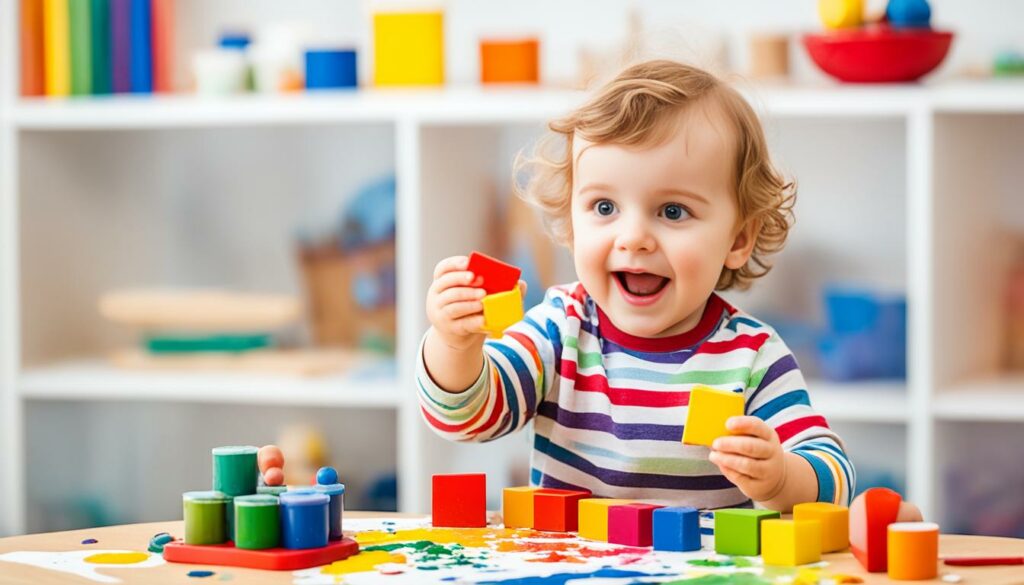
- American Heritage Schools serve 4,600 students grades Pre-K 3 through 12.
- According to research, creativity plays a vital role in childhood development, fostering problem-solving skills, critical thinking, and learning through play.
Cultivating Creativity as Parents
As parents, you have a crucial role in cultivating your child’s creativity. By providing a stimulating environment, offering variety in play, simplicity in toys, and opportunities for social interaction and exploration, you can foster and nurture their creative abilities.
A supportive environment is key to inspiring creativity in children12. Create a space where your child feels encouraged and safe to explore their ideas and express themselves. Fill it with books, art supplies, and open-ended toys that spark their imagination.
Offering variety in play is essential to stimulate your child’s creativity. Instead of overwhelming them with a multitude of toys, focus on a few open-ended options that allow for different possibilities12. Simple toys like building blocks or art materials allow children to engage their imagination and create their own worlds.
Social interaction is another vital aspect of nurturing creativity. Encouraging your child to interact with others in playdates, group activities, or even family games promotes collaboration and offers new perspectives13. Through interaction, children learn to negotiate, communicate their ideas, and work together to bring their imaginative ideas to life.
Outdoor exploration is also a great way to cultivate creativity in children. Nature provides a rich sensory experience and encourages children to observe, discover, and imagine13. Take walks, visit parks, or have picnics in the backyard to expose your child to the wonders of the natural world.
Remember, keeping it simple is crucial. Focus on experiences rather than material possessions. Encourage your child to engage in imaginative play, storytelling, and creative problem-solving rather than relying solely on screens and technology14. By limiting screen time and providing opportunities for hands-on activities, you can help your child develop their creativity in a balanced and healthy way.
In summary, as parents, you have the power to cultivate your child’s creativity by providing a stimulating environment, offering variety in play, simplicity in toys, and opportunities for social interaction and exploration. By nurturing their imagination and encouraging their creative endeavors, you are laying the foundation for a lifelong love of creativity and innovation.
Inspiring Creativity through Hands-On Activities
When it comes to fostering creativity in children, hands-on activities are powerful tools that can ignite their imaginations and nurture their artistic abilities. DIY crafts, storytelling and reading aloud, and incorporating art into daily life provide children with unique opportunities for self-expression and creative exploration.
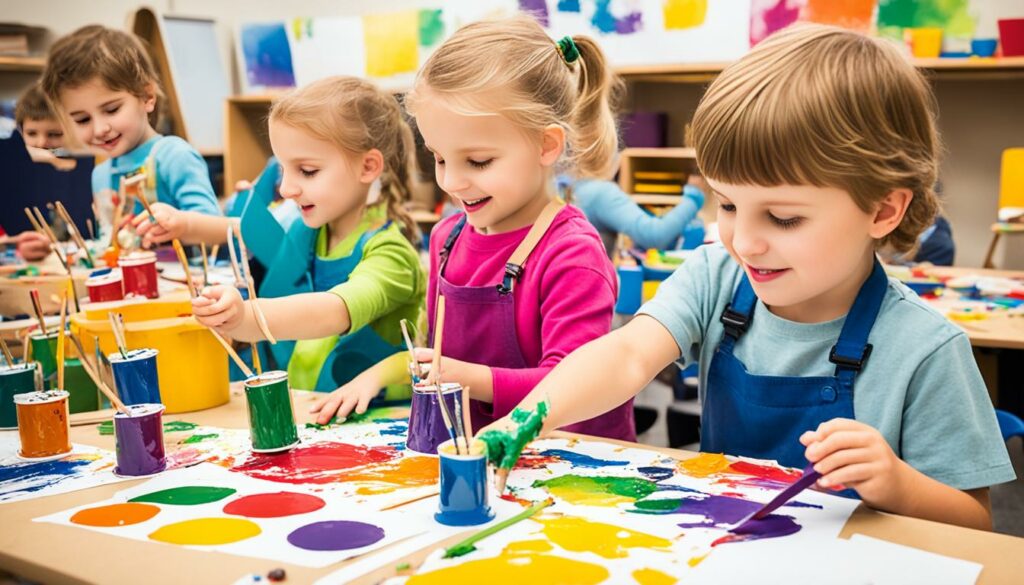
DIY Crafts: Unleashing Creative Expression
Engaging children in DIY crafts allows them to unleash their creative expression and make decisions independently. From painting and sculpting to building models and creating unique handmade gifts, DIY crafts offer endless possibilities for children to explore their imaginations15.
Storytelling and Reading Aloud: Building Narratives
Storytelling and reading aloud play a crucial role in nurturing children’s creativity. By engaging with stories and narratives, children are exposed to different scenarios and endings, stimulating their imaginative thinking15. Whether it’s delving into fairy tales or creating their own stories, storytelling fosters creativity and encourages children to think beyond the confines of reality.
Incorporating Art into Daily Life: Cultivating Creative Skills
Integrating art into daily life provides children with consistent opportunities to cultivate and refine their creative skills. Drawing, painting, and sculpting can become regular practices that allow children to experiment with different techniques and materials while honing their artistic abilities15.
Statistical Data15:
– Journaling promotes self-reflection and awareness among children, helping them gain insights into their past experiences.
– Drawing helps children develop better hand-eye coordination and fine motor skills.
– Painting promotes sensory development and gives children a sense of accomplishment.
– Introducing various painting instruments and mediums like feathers, string, toothbrushes, and acrylics or watercolors can enhance a child’s painting experience.
– Engaging in theme-based art projects can help spark creativity in children and provide them with new avenues for expression.
Encouraging children to engage in hands-on activities like DIY crafts, storytelling and reading aloud, and incorporating art into daily life provides them with rich and fulfilling experiences. These activities not only fuel their passion for creativity but also help develop their cognitive, emotional, and social skills. By embracing these hands-on activities, parents and caregivers can inspire children to unleash their imaginations and express their unique artistic voices.
The Role of Nature in Fostering Creativity
Nature is a powerful catalyst for creativity in children. When kids spend time outdoors, they are exposed to a constantly changing environment that stimulates their curiosity and problem-solving skills. Outdoor play provides endless opportunities for children to engage with natural elements, from drawing in the sand to building forts with branches. The wonders of the natural world inspire imagination, inviting children to think, question, and create.
In today’s digital age, children are spending less time outdoors and more time with technology, resulting in a 50% decrease in the amount of time children spend in unstructured play16. Many parents struggle to get their children outside and recognize the importance of reconnecting with nature.
Engaging with the natural world not only provides a break from technology but also offers a unique setting for creative exploration. Nature-based activities can boost creativity and cognitive development in children of all ages16. From babies to toddlers and older children, nature offers age-specific opportunities to foster imagination and innovation.
For toddlers, nature-based activities can include exploring different textures, observing plants and animals, and creating outdoor artwork16. These experiences ignite their senses and lay the foundation for creative thinking. As children grow, they can engage in imaginative play in natural settings, inventing scenarios and tapping into their creativity17.
Nature is not a place to visit. It is home.
— Gary Snyder
Children aged 8-11 are often faced with the competition between technology and nature. Encouraging unstructured play and providing open-ended materials like building blocks, art supplies, and natural objects can stimulate their imagination and promote diverse use without specific instructions17. Nature serves as a canvas for their creativity, allowing them to explore their interests, experiment, and discover new concepts independently1617.
Studies have shown that spending time in nature reduces stress and improves well-being, contributing to enhanced cognitive abilities and creative thinking18. Nature has a positive impact on humans within the realm of environmental psychology18. However, the potential of nature to stimulate creativity has been minimally explored in psychology and environmental psychology research18. More studies are needed to fully understand the relationship between nature and creativity.
Exploring the natural world allows children to observe, question, and make connections16. Nature serves as a rich source of inspiration, encouraging children to engage in imaginative play, storytelling, and art creation17. Balancing screen time with outdoor play is crucial for their engagement in physical activities, hands-on learning, and the development of creative skills17. Collaborative activities in natural settings also nurture communication skills, expose children to diverse perspectives, and encourage the sharing of ideas to enhance creativity17.
Unlock the potential of nature in fostering creativity in children. Embrace the benefits of the great outdoors, allowing children to explore, discover, and unleash their imagination. The wonders of the natural world await, ready to ignite sparks of creativity and enrich their cognitive and social development.

References:
- A research study exploring the impact of nature on children’s creativity16
- Psychological research on the relationship between nature and creativity17
- Studies on the effects of nature on human well-being in environmental psychology18
Cultivating Creativity in Adverse Environments
Creativity is an innate quality that can thrive even in challenging circumstances. When children find themselves in adverse environments, they often display remarkable resourcefulness and resilience, using recyclable materials to create crafts and toys that reflect their ingenuity and imagination19.
In these challenging circumstances, the ability to overcome limitations through creativity and innovation becomes even more evident. Through their imaginative endeavors, children can find solace, escape, and hope amidst adversity19. Their remarkable capacity to create something out of nothing serves as a testament to the power of creativity.
By nurturing and fostering their creative skills, we can provide children in challenging circumstances with a means of self-expression and confidence. Using recyclable materials for crafts not only promotes sustainability but also empowers children to explore their imagination, strengthens problem-solving abilities, and encourages innovation19. It gives them a sense of ownership and pride in their creations, igniting a spark of creativity that can brighten even the darkest of situations.
Through the transformative power of creativity, children in adverse environments can envision a world of possibilities and overcome the limitations they face. It is a source of inspiration and a catalyst for resilience, enabling them to rise above their circumstances and shape a more hopeful future19.
Creativity as a Lifelong Skill
Creativity is not just important in childhood; it is a lifelong skill. Embracing a creative mindset can fuel personal and professional growth, allowing individuals to navigate the ever-changing world with adaptability and innovation. By nurturing creativity in children, we set them on a path of lifelong learning and exploration, equipping them with the essential skills they need to thrive.
Cultivating creativity from a young age lays the foundation for its impact on personal and professional growth throughout life. Studies have shown that engaging in creative activities from an early age enhances cognitive abilities, critical thinking, and emotional intelligence in children20. Building blocks, puzzles, and imaginative play activate multiple brain areas, improving memory retention and recall20. Creative expression through art, music, and writing can act as a safe outlet for children to express their thoughts and feelings, promoting a deep sense of self-awareness and emotional well-being20.
As children grow, their creativity may face challenges due to social pressure and conformity. Adolescents, in particular, often struggle to maintain their creative spirit amidst the need to fit in and adhere to societal norms. However, creating a safe space at home for children to break conventions and go against peer norms can foster creativity and encourage them to embrace their unique ideas and perspectives.
Encouraging experimentation in problem-solving and reflecting on different approaches can facilitate creative thinking and nurture an innovative mindset20. Providing open-ended materials for exploration across subjects, such as construction sets and art supplies, stimulates imaginative thinking and problem-solving skills20. Research suggests that people are more creative when they have privacy and are not interrupted, emphasizing the importance of quiet space for creativity to flourish20.
Moreover, technology can play a valuable role in fostering creativity. Online creativity sites provide children with opportunities to explore new ideas, gain inspiration, and engage in a safe environment where they can share their creations with others20. Asking open-ended questions that foster original ideas can stimulate creativity in children, encouraging them to think outside the box and explore the limitless possibilities of their imagination.
By recognizing and nurturing creativity as a lifelong skill, we empower individuals to embrace a creative mindset that supports personal and professional growth. Creativity opens doors to innovation, problem-solving, and adaptability, allowing individuals to navigate the complexities of the world with confidence, curiosity, and resilience.
Unlocking the Potential of Imagination
Imagination is the catalyst for innovation, providing a spark of inspiration that unlocks the limitless possibilities of creativity in children. It is through imaginative play that young minds can fully explore their ideas and bring them to life. By encouraging imaginative play, parents and caregivers lay a strong foundation for fostering creativity and critical thinking in children21.
Imaginative play serves as a foundation for creativity and problem-solving skills. When children engage in open-ended play activities like building with blocks or playing make-believe, they develop a unique set of cognitive abilities that enable them to think outside the box and find creative solutions to challenges they encounter22. This form of play allows children to tap into their creative potential and refine their problem-solving skills as they navigate the scenarios they create.
Research indicates that providing children with access to a variety of materials for creative activities stimulates their innovation and imaginative thinking abilities22. By offering a multitude of art supplies, craft materials, and other resources, parents and caregivers empower children to express themselves creatively and explore different forms of artistic expression. This variety stimulates their imagination and encourages experimentation, fostering their creative growth and sparking new ideas.
Modeling creativity and imaginative thinking is another effective way to unlock the potential of imagination in children. When caregivers showcase their own creative expression and exploration, children are inspired to do the same. The act of observing and emulating creative behaviors enhances children’s own creative abilities and boosts their self-confidence22. By nurturing their natural curiosity and providing a supportive environment, parents and caregivers can fuel the fire of imagination within each child, empowering them to explore new ideas and embrace their unique creative potential.
Cultivating an environment that supports and celebrates children’s unique talents and creativity has been shown to have a significant impact on their overall well-being and positive development22. When children feel encouraged and appreciated for their creative endeavors, their self-esteem and confidence soar, allowing them to fully embrace their imaginative potential. By nurturing a culture that values creativity and celebrates each child’s artistic expression, parents and caregivers can help unlock their imagination and put them on a path of lifelong creative exploration.
Encouraging children to take risks and embrace failure as part of the creative process is crucial to fostering resilience and perseverance skills. When children understand that failure is a natural part of learning and growth, they become more willing to experiment and push the boundaries of their imagination. This mindset fosters resilience, teaching children to bounce back from setbacks and persist in the face of challenges, ultimately leading to greater creative achievements22.
Overall, imagination serves as the foundation for unlocking the creative potential within each child. By embracing imaginative play, providing access to creative materials, modeling creativity, creating a supportive environment, and encouraging resilience, parents and caregivers can nurture the limitless possibilities of imagination in children, empowering them to innovate, create, and make a positive impact in their lives and the world around them21.
Conclusion
Fostering creativity in children is essential for their overall development. By nurturing their imagination, providing stimulating environments, and engaging in hands-on activities, parents and caregivers can unlock the potential of creativity in children. Whether in challenging circumstances or everyday life, creativity holds immense power to shape the future and inspire innovation.
Studies have shown that percentage of critical thinkers and problem solvers develop these skills through engaging in creative activities during childhood23. Creativity and imagination are identified as crucial elements in childhood development24. They impact cognitive, emotional, and social growth in children and contribute to the development of cognitive and social skills2425. In schools that emphasize creativity fostering techniques, students display higher creativity levels compared to those in schools with standardized testing23.
Children who are exposed to creativity at a young age are more likely to develop a lifelong love of learning and a growth mindset23. The demand for creative skills in the job market is also increasing due to automation and artificial intelligence23.
Nurturing children’s creativity and imagination is a rewarding journey with lifelong benefits24. Parents and caregivers play a crucial role in unlocking their creative potential by providing a supportive and nurturing environment24. Encouraging a love for reading and storytelling can enhance children’s creativity24. Cultivating creativity in children sets them on a path of lifelong learning and equips them with essential skills for success in academics, careers, and life24.
Let us embrace and nurture the creative minds of our children for a brighter tomorrow. Together, we can shape a future driven by innovation and limitless possibilities24.
FAQ
How does nurturing creativity in children benefit their development?
What role does imagination play in child development?
What are some strategies for nurturing creativity in children?
How can creativity be fostered in challenging circumstances?
When does creativity begin to develop in children?
What is the role of parents in cultivating their child’s creativity?
How can hands-on activities inspire creativity in children?
What role does nature play in fostering creativity?
How can creativity be cultivated in adverse environments?
Is creativity only important in childhood?
How does imagination unlock the potential of creativity?
Source Links
- https://www.brighthorizons.com/resources/Article/nurturing-creativity-and-imagination-for-child-development
- https://janpetersoncdc.com/blog/from-scribbles-to-masterpieces-fostering-creativity-in-young-minds/
- https://www.startearly.org/post/imaginative-play/
- https://www.miracle-recreation.com/blog/importance-of-imagination-in-child-development/
- https://www.celebree.com/7-ways-to-nurture-your-childs-creativity-and-imagination/
- https://online.maryville.edu/online-bachelors-degrees/psychology/resources/creativity-for-kids-benefits-tips-for-nurturing-an-innovative-mind/
- https://today.uconn.edu/2021/10/how-to-nurture-creativity-in-your-kids-2/
- https://drexel.edu/soe/resources/teacher-resources/inspire-creativity-in-the-classroom/
- https://richardjamesrogers.com/2023/04/03/5-excellent-ways-educators-can-foster-creativity-in-students/
- https://va-itsnetwork.org/the-importance-of-fostering-creativity/
- https://www.ahschool.com/blog/read-more/~board/blog/post/11-ways-to-foster-creativity-in-children
- https://ideas.ted.com/10-tips-for-cultivating-creativity-in-your-kids/
- https://www.virtuallabschool.org/fcc/creative-expression/lesson-3
- https://www.streamsemester.com/articles/cultivating-creativity-in-children
- https://mentalhealthcenterkids.com/blogs/articles/creativity-activities-for-kids
- https://biglifejournal.com/blogs/blog/fostering-creativity-imagination-for-children-development
- https://www.parent.app/blog/foster-creativity-and-imagination-in-young-children
- https://www.sciencedirect.com/science/article/abs/pii/S1618866715000138
- https://extension.missouri.edu/publications/gh6041
- https://www.brilliantbrainz.com/the-science-of-creativity-how-it-helps-your-childs-brain-development/
- https://thearkgroup.org/fostering-creativity-and-imagination-in-children-a-guide-for-parents
- https://beakid.com/articles/fostering-creativity-and-imagination-in-children-the-key-to-unlocking-their-potential-62834735-35f0-4c1e-9af2-53664c40088e
- https://everydayeducate.com/blogs/news/fostering-creativity-in-children-why-it-matters-and-how-you-can-help
- https://thearkgroup.org/fostering-creativity-and-imagination-in-children-a-guide-for-parents/
- https://www.ncbi.nlm.nih.gov/pmc/articles/PMC10699610/

